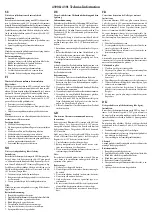
33
8018478/YWL5/2018-06| SICK
O P E R A T I N G I N S T R U C T I O N S | NAV245
Subject to change without notice
PRODUCT DESCRIPTION
3
3.8.5
Digital output
The NAV245 has a digital output which is used to synchronize the internal clock of the
NAV245 and the vehicle computer. Depending on the synchronization method, the output
provides a 10 or 20 ms pulse (“Synchronizing the clock in the automated guided vehicle
and the NAV245” on page 33). The pulse is output depending on the synchronization
method. The default value is Active High.
.
Fig. 22: Synchronization pulse
The polarity of the digital output can be reversed. The setting should be set to „Active High“
and it should be triggered on the rising edge.
3.8.6
Synchronizing the clock in the automated guided vehicle and the NAV245
For precise control, you must synchronize the timings of the landmark data from the
NAV245 and the calculations in the vehicle computer as accurately as possible.
The measurement data from the NAV245 is provided with the time stamp of the NAV245.
The internal time stamp in the NAV245 is a 32-bit counter which increases in increments of
1 every 1
μ
s.
The NAV245 has two options available for synchronizing the internal time of the NAV245
with the system time of the vehicle computer.
1
Via telegram
The vehicle computer retrieves the internal time of the NAV245 using a telegram.
The NAV245 writes its internal time in a telegram and sends this to the vehicle computer.
2
Via telegrams and adjustment via the digital output of the NAV245 (Output 1 or 2:
Reading timer)
The vehicle computer retrieves the internal time of the NAV245 using a telegram.
The hardware output provides a pulse of at least 20 ms once the internal time stamp is
written in the telegram. If the telegram is then received by the vehicle computer, this can
add the delta between the pulse and receipt to the time entered in the telegram. As a
result, the automated guided vehicle can determine the actual time in the NAV245.
5/20 ms
















































